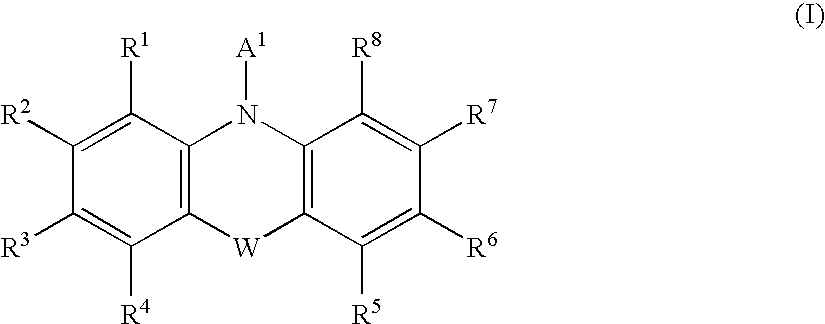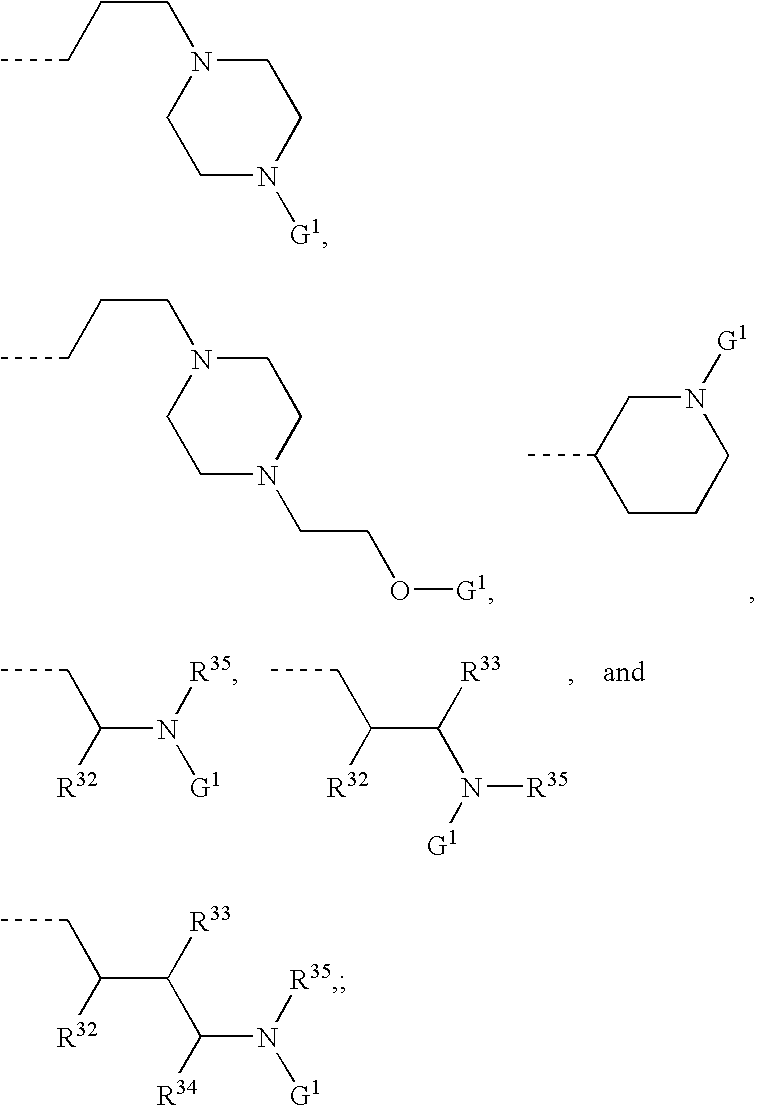Formulations, conjugates, and combinations of drugs for the treatment of neoplasms
a technology for neoplasms and conjugates, applied in the field of neoplasm treatment, can solve the problems of destroying healthy tissue, affecting the treatment of cancer, and affecting the treatment effect, and achieve the effect of reducing the occurrence of side effects
- Summary
- Abstract
- Description
- Claims
- Application Information
AI Technical Summary
Benefits of technology
Problems solved by technology
Method used
Image
Examples
example 1
Protection and Deprotection of Reactive Groups
The synthesis of phenothiazine conjugates may involve the selective protection and deprotection of alcohols, amines, ketones, sulfhydryls or carboxyl functional groups of the phenothiazine, the linker, the bulky group, and / or the charged group. For example, commonly used protecting groups for amines include carbamates, such as tert-butyl, benzyl, 2,2,2-trichloroethyl, 2-trimethylsilylethyl, 9-fluorenylmethyl, allyl, and m-nitrophenyl. Other commonly used protecting groups for amines include amides, such as formamides, acetamides, trifluoroacetamides, sulfonamides, trifluoromethanesulfonyl amides, trimethylsilylethanesulfonamides, and tert-butylsulfonyl amides. Examples of commonly used protecting groups for carboxyls include esters, such as methyl, ethyl, tert-butyl, 9-fluorenylmethyl, 2-(trimethylsilyl)ethoxy methyl, benzyl, diphenylmethyl, O-nitrobenzyl, ortho-esters, and halo-esters. Examples of commonly used protecting groups for a...
example 2
Polyguanidine Conjugates of Phenothiazines
2-(trifluoromethyl)phenothiazine (CAS 92-30-8, Aldrich Cat. No. T6,345-2) can be reacted with an activated carboxyl. Carboxyls can be activated, for example, by formation of an active ester, such as nitrophenylesters, N-hydroxysuccinimidyl esters, or others as described in Chem. Soc. Rev. 12:129, 1983 and Angew. Chem. Int. Ed. Engl. 17:569, 1978, incorporated herein by reference. For example, oxalic acid (Aldrich, catalogue number 24,117-2) can be attached as a linking group, as shown below in reaction 1.
The protecting group in the reaction product can be removed by hydrolysis. The resulting acid is available for conjugation to a bulky group or a charged group.
The polyguanidine peptoid N-hxg, shown below, can be prepared according to the methods described by Wender et al., Proc. Natl. Acad. Sci. USA 97(24): 13003-8, 2000, incorporated herein by reference.
The carboxyl derivative produced by the deprotection of the product of reactio...
example 3
Hyaluronic Acid Conjugates of a Phenothiazines
2-Methylthiophenothiazine (CAS 7643-08-5, Aldrich Cat. No. 55,292-5) can be reacted a hydrazine-substituted carboxylic acid, which has been activated as shown in reaction 3.
The protecting group can be removed from the reaction product and the free hydrazine coupled to a carboxyl group of hyaluronic acid as described by, for example, Vercruysse et al., Bioconjugate Chem., 8:686, 1997 or Pouyani et al., J. Am. Chem. Soc., 116:7515, 1994. The structure of the resulting hydrazide conjugate is provided below.
In the phenothiazine conjugate above, the hyaluronic acid is approximately 160,000 Daltons in molecular weight. Accordingly, m and n are whole integers between 0 and 400. Conjugates of lower and higher molecular weight hyaluronic acid can be prepared in a similar fashion.
PUM
| Property | Measurement | Unit |
|---|---|---|
| hyaluronic acid | aaaaa | aaaaa |
| alpha-1-acid glycoprotein | aaaaa | aaaaa |
| heterogeneity | aaaaa | aaaaa |
Abstract
Description
Claims
Application Information
 Login to View More
Login to View More - R&D
- Intellectual Property
- Life Sciences
- Materials
- Tech Scout
- Unparalleled Data Quality
- Higher Quality Content
- 60% Fewer Hallucinations
Browse by: Latest US Patents, China's latest patents, Technical Efficacy Thesaurus, Application Domain, Technology Topic, Popular Technical Reports.
© 2025 PatSnap. All rights reserved.Legal|Privacy policy|Modern Slavery Act Transparency Statement|Sitemap|About US| Contact US: help@patsnap.com



